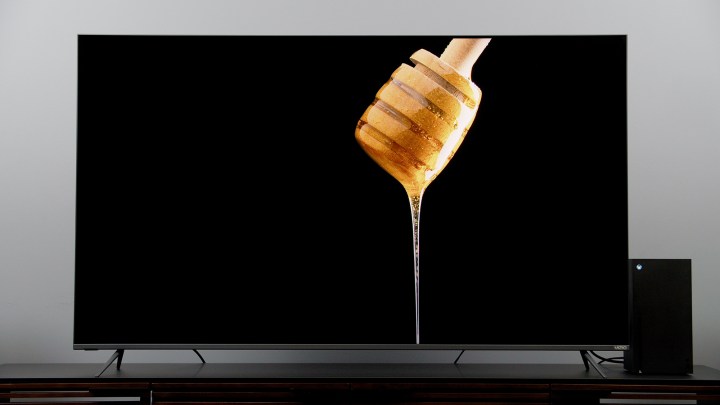“One of the best values in high-performance TV.”
- Excellent HDR brightness for the price
- Solid on-angle black levels
- Excellent color coverage
- HDMI 2.1 ports
- Feature-loaded
- Potential local dimming bug
- Game console sync bug
- Poor off-angle contrast
After reviewing the Vizio P-Series Quantum X (PQX for short), I wondered if folks really needed all the bells and whistles Vizio’s most premium set had to offer. For a few hundred dollars less, I was hoping the step-down Vizio P-Series Quantum (PQ9 for short) would be “all killer, no filler.” What do you lose when you lose the “X”? Let’s find out.
Vizio P-Series Quantum 4K HDR TV details
While we reviewed the 65-inch model, our review also applies to the 75-inch model.
| Screen Size | Model Number | MSRP |
| 65-inch | P65Q9-H1 | $1,200 |
| 75-inch | P75Q9-H1 | $1,700 |
Out of the box
The box comes with Vizio’s standard (non-voice) remote, batteries, and two easy-to-install metal feet along with four screws. Much like the Quantum X, the back of the PQ9 is pretty straightforward, housing a power port and speakers, and inputs shaped in an “L” pattern toward one side. The inputs include analog and optical audio, four HDMI ports (with eARC on port 1), composite video, and USB. While only the third and fourth HDMI inputs are labeled as supporting
Much like the PQX, the PQ9 is an attractive TV. There are virtually no bezels on the top and sides, and just a thin metal strip at the bottom. Vizio’s logo resides on the right side of the bottom border and there’s an inconspicuous power light on the left. Considering the PQ9 has a full-array local-dimming backlight system, the TV doesn’t have an especially deep profile.
The PQ9 sits just far enough above an entertainment stand that one of Vizio’s soundbars (we used the M-Series 5.1 soundbar can slide right underneath, making for one of the most inconspicuous soundbar arrangements I’ve seen.
If I have anything to complain about regarding the TV’s design, it’s that there’s no cable management to speak of. With a soundbar in place, you aren’t likely to see cables dangling, but with nothing blocking the view, cables were quite visible.
Basic settings

Getting picture settings taken care of is a slightly less bothersome process than with other
In my experience, the easiest way to go about doing this is to open up the YouTube app on the TV, play some piece of SDR content, then navigate to the picture settings menu and select the Calibrated picture pre-set. Navigate further down the picture settings menu to advanced settings, then motion control and, if you don’t want the “soap opera effect” turn down de-judder and de-blur from two to zero.
Next, pull up a YouTube video in
For
Repeat the above three processes for an HDMI input and you should be set.
Color performance

After I chose the above settings, I measured the PQ9’s white balance, which gives a good at-a-glance indication of color accuracy. Since white is comprised of red, green, and blue colors, I can tell if those colors are being produced in balance. From my testing, I could see the PQ9 leaned a little too heavily toward red — an attribute I noted was present in the PQX. However, it took much less time and tweaking to get the PQ9 adjusted, and there was less of a redshift in the bright whites than with the PQX. Perhaps that’s because the PQ9 doesn’t get as bright, but nonetheless, I call it an advantage.
Broadly speaking, the colors look rich, vibrant, and pleasing to look at, and I didn’t anything off-putting that the average viewer would detect. My tests confirmed that the Vizio isn’t dead-on accurate with color, but it is close enough for most folks. Also, the PQ9 produces a very wide range of colors at varying brightness levels, which makes for some very satisfying
In
Brightness

After running some tests, I found the PQ9 was hitting almost 550 nits in SDR mode — which provides a bright picture, but in SDR you won’t get a lot of bright highlight detail. While you could go brighter for bright room scenarios by maxing out the backlight setting, in darker rooms that could lead to a washed-out picture.
In
Backlight
It’s true that the PQ9 produces some halo or blooming effect when you have bright objects against a really dark, black background, and that black areas tend to be grayed out a bit — we could see the screen light up when there were subtitles over black letterbox bars. But the fact is, almost all LED-backlit TVs do this and I think Vizio has done an admirable job mitigating the issue.

It wasn’t much of a problem when facing the set head-on from the direct center, but once off-center you can see things clouding up. Again, this is typical of VA-type LCD panels, but it seemed especially severe here compared to some of the other TVs we’ve reviewed this year. To be fair, though, those competing TVs were more expensive and didn’t get as bright. I think we’re looking at a trade-off situation where you have to spend quite a bit more to get similar brightness with better backlight control. (It is worth noting that we kept the Active Full Array backlight setting to medium for SDR, HDR, and Dolby Vision, as that provided the best results.)
Now for an issue that both I and Vizio found to be rather vexing: With my review sample, the backlight appeared slow to react in some test clips that track a little white box around a black screen. Also, pulling out of Netflix content and back to the title screen, I could see it dim and then brighten back up as it’s figuring out what to do. I call it local dimming lag.

In testing actual content to clarify if the issues were or weren’t restricted to just logos and test screens, we did see the backlighting being slow to react, which I can see being problematic in dark rooms where our eyes are more sensitive to shifts in brightness.
Screen uniformity on my PQ9 sample was not particularly great.
Local dimming lag is known to happen. I’ve seen it on a bunch of televisions. But this lag seemed extreme by comparison, including to other TVs in Vizio’s line-up. It looks like a bug of some kind, but Vizio and I had a tough time tracking it down. Vizio has informed me it is not hearing widespread reports of this kind of trouble, so it is quite likely the issue is restricted to the test sample I have, but if I have it, others could too.
Uniformity

Screen uniformity on my PQ9 sample was not particularly great. I could see vertical bands pretty clearly in images with broad swathes of color, and there was some heavy vignetting in the corners where brightness goes down a bit. Again, however, this dirty screen effect and vignetting will vary from panel to panel, so your mileage may vary.
Motion

The PQ9’s motion handling of 24 fps movie content looks great. There’s no serious judder with the set’s Film Mode turned on, although we could see some stutter with some 30 fps content. (That stutter can be eliminated with motion smoothing, but again you get the “Soap Opera Effect,” which in most cases makes things look worse in general.)
When there’s an abundance of fine detail to track, you may see some shimmering in those objects, which is something we’ve seen on a lot of TVs this year. There’s something about high brightness married to fine detail that seems to be tricky for current processors.
On the plus side, I didn’t witness any excessive moire patterns in tight geometric patterns on the PQ9, indicating its processor is doing a pretty fine job, indeed
Gaming
There has been a lot of trouble getting
The gameplay was excellent, with extremely low input lag and great
Connecting an Xbox Series X is supposed to be an automated process, with the console detecting the TV’s capabilities and applying the correct video settings automatically. Unfortunately, there’s a bug present that requires a quick settings adjustment to get everything communicating well with each other.

To make the adjustment, go to Picture Settings and scroll down to the bottom of the menu where you’ll find “Input Settings.” By default, the TV will be in “Auto,” but it is necessary to force it to HDMI 2.1 in order for the
Gameplay highlighted the slowness of the backlighting issues we mentioned above, especially around the menus for the games. But aside from that — which we know might be a bug with this sample — the gameplay was excellent, with extremely low input lag and great
Our take

I started with the question of whether the PQ9 is the smarter buy as a less expensive TV than the PQX. Based on what I experienced, I can’t make a definitive call.
To be sure the PQ9’s brightness is sufficient for impressive
Is there a better alternative?
No. With its superior brightness and black levels, the Vizio PQ9 is in a class all its own. Samsung’s comparably priced Q70T is not nearly as well equipped or exciting to watch. TCL’s 8-Series is a close match in terms of price and performance, but it’s on clearance and tough to buy now. When on sale, LG’s Nano90 is very competitive, but that TV is also on its way out as new 2021 models are shipping to retail outlets. So, really, for a $1,200 65-inch TV with its specs and performance, the Vizio P-Series Quantum can’t be touched.
How long will it last?
Given Vizio’s track record of overall build quality and the PQ9’s
Warranty
Vizio provides a one-year warranty on its TV products. More information can be found on Vizio’s warranty page.
Should you buy it
Yes, but only if you have the option to return it should you run into the local-dimming issue I experienced with my review sample. At this point, I feel encouraged by a low return rate on the PQ9, and the fact is this TV offers tremendous performance for the price.
Editors' Recommendations
- Vizio’s new Quantum 4K QLED TVs hit 75 inches for $699
- Vizio’s 2021 TV line has new QLEDs with 3,000 nits of eye-searing brightness
- This 60-inch Vizio 4K Smart TV gets a huge $250 price cut at Walmart
- This 65-inch Vizio 4K HDR Smart TV gets a huge price cut at Walmart





